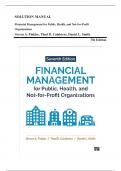SOLUTION MANUAL
Financial Management for Public, Health, and Not-for-Profit
Organizations
Steven A. Finkler, Thad D. Calabrese, Daniel L. Smith
M
7th Edition
ED
C
O
N
N
O
IS
SE
U
R
, Instructor’s Manual for Financial Management for Public, Health, and Not-for-Profit Organizations,1
2E
INTRODUCTION
Chapter 1 TO
M
FINANCIAL
MANAGEMENT
ED
Questions for Discussion
1-1. Financial management is the subset of management that focuses on generating financial information
that can improve decisions. The decisions are oriented toward achieving the various goals of the
organization while maintaining a satisfactory financial situation. Financial management encompasses
C
the broad areas of accounting and finance.
1-2. In proprietary, or for-profit, organizations, an underlying goal is to maximize the wealth of the
O
owners of the organization.
1-3. In public service organizations, decisions are oriented toward achieving the various goals of the
N
organization while maintaining a satisfactory financial situation.
1-4. Accounting is a system for keeping track of the financial status of an organization and the financial
N
results of its activities. It has often been referred to as the language of business. The vocabulary
used by accounting is the language of nonbusiness organizations as well.
O
1-5. Accounting is subdivided into two major areas: managerial accounting and financial accounting.
Managerial accounting relates to generating any financial information that managers can use to
improve the future results of the organization. This includes techniques designed to generate any
IS
financial data that might help managers make more effective decisions. Major aspects of managerial
accounting relate to making financial plans for the organization, implementing those plans, and then
working to ensure that the plans are achieved. Some examples of managerial accounting include
SE
preparing annual operating budgets, generating information for use in making major investment
decisions, and providing the data needed to decide whether to buy or lease a major piece of
equipment. Financial accounting provides retrospective information. As events that have financial
implications occur they are recorded by the financial accounting system. From time to time (usually
monthly, quarterly, or annually), the recorded data are summarized and reported to interested users.
The users include both internal managers and people outside the organization. Those outsiders
U
include those who have lent or might lend money to the organization (creditors), those who might
sell things to the organization (called suppliers or vendors), and other interested parties. These
interested parties may include those with a particular interest in public service organizations, such as
R
regulators, legislators, and citizens. Financial reports provide information on the financial status of
the organization at a specific point in time, as well as reporting the past results of the organization‘s
operations (i.e., how well it has done from a financial viewpoint).
, Chapter 3: Additional Budgeting Concepts 3-2
1-6. Finance focuses on the alternative sources and uses of the organization‘s financial resources.
Obtaining funds when needed from appropriate sources and the deployment of resources within the
organization fall under this heading. In addition, finance involves the financial markets (such as
stock and bond markets) that provide a means to generating funds for organizations.
M
1-7. Yes. Achieving the goals of the organization requires financial planning. Financial management
provides information for managers to use in making their decisions. It helps managers by
ED
providing information on the likely financial impact of each proposed alternative. It also provides
information about financial stability, efficiency, and effectiveness.
1-8. Clearly, we might expect some public service organizations that are proprietary, such as some
hospitals, to earn profits. But what about other public service organizations such as charities? They
should make a profit as well. Profits provide a safety margin against unexpected costs, provide
C
resources to replace buildings and equipment, and to expand and improve services.
1-9. Federal government (see text Figure 1-1)
O
Individual income taxes
Social insurance taxes
Corporate income tax
N
State and local government (see text Figure 1-4)
Sales and gross receipts tax
N
Federal government
Property taxes
Individual income taxes
O
Health sector (see text Figure 1-6)
Private insurance
IS
Medicare
Medicaid
Other government programs
SE
Not-for-profit sector (see text)
Private payments for goods and services
Government payments for goods and services
Donations
U
1-10. Federal government spending exceeded $6 trillion in 2020 and state and local government spending
was more than $3 trillion in 2018. In contrast, the GDP was $21 trillion in 2020. For more up to
date information, examine the statistical tables of the most recent Economic Report of the
R
President, which is available online.
1-11. The reported surplus includes both on and off budget items. Social security taxes represent an off
budget item that until recently raised more revenue than was spent on social security payments.
, Finkler, Financial Management for Public, Health, and Not-for-Profit Organizations 7e
© CQ Press, 2023
The surplus in this area offset other government losses, and even resulted in an overall surplus for
the federal government. This is no longer the case, and, over time, trust fund resources will be used
up to provide benefits. As the federal government will not have access to the excess resources from
social security, it will have to borrow and increase the total level of federal debt, unless revenues or
M
spending are changed.
1-12. Sometimes gifts come with strings attached. If the conditions of the gift create a burden that the
ED
organization does not want to accept, or somehow requires the organization to work in opposition
to its mission, it might turn down the gift.
1-13. The World Bank has defined NGOs as "private organizations that pursue activities to relieve
suffering, promote the interests of the poor, protect the environment, provide basic social services,
or undertake community development" (World Bank Operational Directive 14.70). NGOs are quite
C
similar to the not-for-profit organizations. They are primarily mission-focused rather than profit-
focused. NGOs fall into three main categories: community-based, national, and international.
O
N
PLANNING
Chapter 2 FOR
N
SUCCESS:
O
BUDGETING
Questions for Discussion
IS
2-1. Planning helps the organization by causing its employees to think ahead and anticipate change.
This is done by establishing specific goals and objectives, communicating those objectives to the
individuals who must achieve them, forecasting future events, developing alternatives, selecting
SE
from among alternatives, and coordinating activities. The activities are summarized in a document
called a budget. The budget describes what we hope to achieve and the resources that will be used
to carry out the organization‘s activities.
2-2. The organization‘s mission represents its reason for existence. For public, health, and not-for-
U
profit organizations, finances often become a means to an end, rather than the end itself. This
mission cannot solely be making profits. Financial management must help balance the focus on
profit with the public service elements of the organization‘s mission.
R
2-3. Strategic plans translate the mission of the organization into an approach or set of approaches that
will be used to accomplish the mission, and a broad set of goals that need to be attained to
achieve the mission. Strategic plans set the organization‘s long-term direction. They often do not





